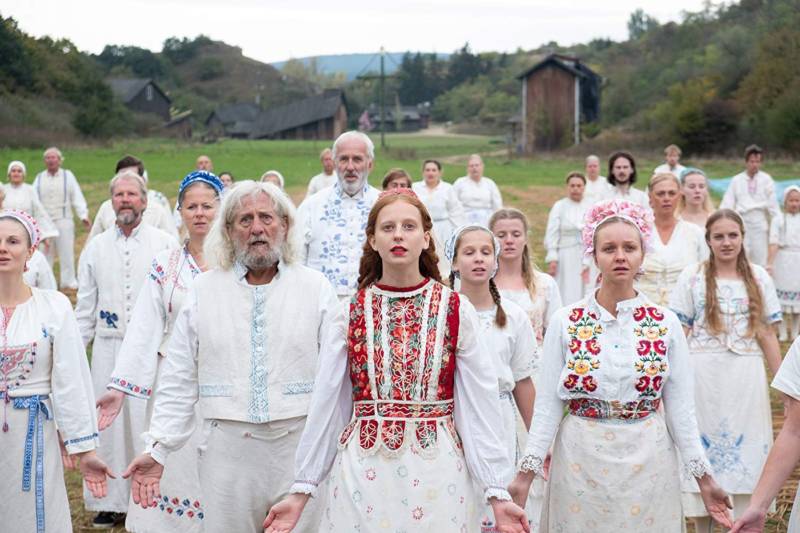This tapping into our subconscious selves can quietly have another unintended consequence. Because of the way these movies juxtapose the familiar and the freaky, they can leave behind a residue that suggests it's wise to fear all religions that are not our own. 1973's The Wickerman is a great example of this. In it, we see stern policeman Sergeant Howie leave the British mainland in pursuit of a missing girl. He lands on Summerisle, an isolated island off the coast of Scotland, where he is greeted by a community of pagans, who revel in mocking him at every turn.
The Wickerman plays on old ideas about Paganism that were spread by Christian settlers when they first arrived in Great Britain. Signs of the struggle between the religions remain in the UK today. Most notably in Avebury, England, where you can see the largest stone circle in the world—believed to have been built by druids for religious and ceremonial purposes—with a Christian church sitting jarringly in the middle of it.
Sergeant Howie then, represents good, civilized Christianity, while the occupants of Summerisle represent the hedonism and heathenism of Paganism. He is order; they are chaos. He is virginal; they are overtly sexual. He is sober; they drink 'til they literally fall down. The Sergeant clings faithfully to his uniform and procedures but ultimately finds that both are meaningless in a community that does not share his values. In the end, Howie's rule book is no match for the islanders' ancient ceremonies.
In a recent conversation with writer/director Ari Aster, Jordan Peele said he believes that Midsommar "usurps The Wicker Man as the most iconic Pagan movie." Peele notes that "the final act ... was some of the most atrociously disturbing imagery I’ve ever seen on film, and yet I experienced it with this open-mouthed, wild-eyed gape. I think that part of how we get there is never reducing the villains to any kind of snarling monsters with an evil agenda." They are merely "Other."
Just as a line was drawn in The Wicker Man between the civilized mainland and the barbarism of Summerisle, Children of the Corn asks us to recognize a gulf between the religious and the educated; the backwards country yokel versus the sophisticated city dweller. It is a movie that asks us to embrace intellect, instead of faith.
Even before a cult of fundamentalist children has tried to murder them, Vicky and her doctor boyfriend, Burt, make fun of a radio preacher as they drive the backroads of Nebraska. As the holy man enthusiastically lists the sinners that heaven has no room for, Burt shouts along sarcastically: "No room for the college graduate! No room for people who watch public television!"
In this world, the city folk are educated, principled and free, while small town people are uneducated, insular and easily controlled—all because of religion. The children can be commanded by their leader, Isaac, to go and kill, and before they do, they chant "Praise God! Praise the Lord!" It is left to Burt to attempt to reason with the brainwashed children. "Any religion without love and compassion is false," he tells them. (How many of us would like to say the same to the Westboro Baptist Church?)
Religious sect horror movies don't just tell us to fear the belief systems of outsiders, they tell us that other people's religions can be so pernicious, they can take hold of those closest to us before we've even had a chance to notice. This is the fate that befalls Rosemary Woodhouse in Rosemary's Baby.
Rosemary's husband sacrifices her eternal life and provides their firstborn son as a human vessel for the devil after he is bribed and influenced by the couple's neighbors, the Satan-worshipping Castavets. The Castavets' advanced age and doddering ways represent the fact that one of the powers of corrupting religions is their ability to look perfectly harmless at the outset.
A similar message is put forth by Hereditary. In it, ordinary family life is invaded by unseen forces of darkness, wrought by a religious sect too power-hungry and spiritually powerful to fight against. In this family's battle for peace and normality, traditional symbols of comfort—a hearth, a bed, a tree house—all become traps in which Annie Graham's family are at their most vulnerable. Visually, the brightest light is invaded by opaque darkness. In the end, the biggest evil-doer of all turns out to be grandma.
Much has been made of Hereditary being a metaphor for inherited mental illness and disease, but it also plays on ideas around religious radicalization and the eternal tolls suffered by the families left behind.


